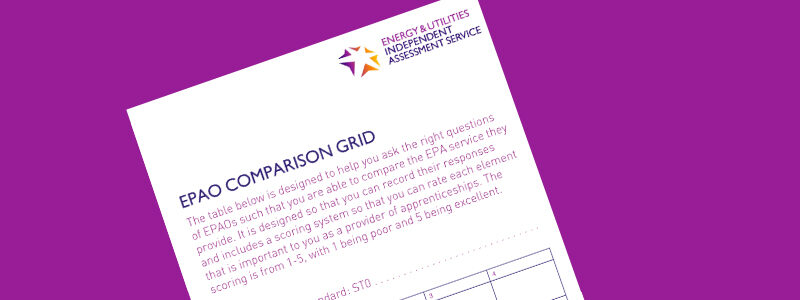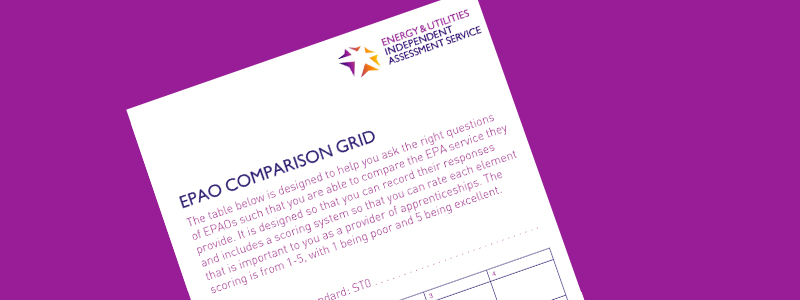Published on: October 26, 2021 at 2:46 PM
Guide to ensure a smooth transition when considering changing EPAO

What to consider when switching your EPAO?
There are plenty of money wise gurus out there telling you to switch your electricity or gas supplier, switch your car insurer, change your bank, or telling you to upgrade, re-finance, cash-in etc. etc. Indeed, switching has pretty much become the norm in our domestic lives, yet when it comes to work, changing supplier is less routine. If you deliver apprenticeship training your choice of end point assessment organisation (EPAO) is stated when first registering your apprentices on the Digital Apprenticeship Service (DAS).
So! Should you switch?
The selection of an EPAO may well have been made rather hastily in order to complete the field within the registration process. The registration is hooked up with the Apprenticeship Assessment Service. This is the system used by EPAOs to claim apprentice certificates and apply for ESFA approval to offer End Point Assessment (EPA). The system informs your stated EPAO of your choice. Most EPAOs will subsequently make contact with you to provide information on their gateway processes.
However, well before gateway it is good practice to look at your choice of EPAO again. It could be several years since you made your choice of EPAO. Since then, new EPAOs are likely to have entered the market. It is also possible that the EPAO you originally selected has either chosen to withdraw their approval or had it removed. The EPAO sector is in a transitional phase, due to a change of the inspectorate body for external quality assurance. EPAOs are evaluating their provision and dropping some EPA out of their portfolios.
Firstly, look at the “Find an end-point assessment organisation for your apprentice” website; enter the title of the apprenticeship and you will be provided with a list of the EPAOs who are approved to offer that standard. Links to their respective websites are included in the listing.
Next, go to the “Find an assessment opportunity” website to check that the EPAO offers assessments in your region. This site also provides interesting regional statistics on the number of active and completed apprentices.
Lastly, check the Register of End Point Assessment Organisations websiteto confirm that the EPAO is on the register and to obtain their EPAO registration number. You can also check to see what other EPA they offer. On this site you will find a contact name and an email address which can be useful when first approaching an EPAO.
You will now have a list of potential EPAOs who offer the apprenticeship standards you deliver. We gave created a comparison grid to help you collate your findings and inform your decision. Please see below for details on how to request your free copy of the comparison grid.
Macro Considerations
There are macro and micro considerations, and risks, to switching EPAO. The macro considerations are the bigger picture aspects of procurement. Your standard due diligence checks will include checking company status to ensure that they are an entity with whom you can do business. Also important is their reputation and track record. For example, are they well-connected to the sectors where they offer EPA? Other considerations might include:
- Has the EPAO been Ofqual recognised? Over the next two years, all EPAOs will require Ofqual recognition. Is there a risk that the EPAO will fail to achieve recognised status and thereby removed from the Register?
- Are they a specialist EPAO; will they understand the setting and context of your industry? Knowing how important a suite of apprenticeships is to the EPAO is a good indicator of their commitment to a sector and the likelihood of them having the right contacts to recruit sector competent independent assessors and their ability to offer knowledgeable technical support.
Micro Considerations
Take a look at the information you have been sent by the EPAO that you originally listed on the Digital Apprenticeship Service. Have they been in contact? Have they assigned, or will they assign a named account manager for your cohort of apprentices? How easy has it been to communicate with them so far? This is a vital indicator of the quality of customer service you are likely to receive. Some EPAOs rarely offer face to face meetings, even if run remotely. A dedicated account or case manager who can take you through the end-to-end process, who answers calls and responds to emails in a timely manner is a great asset!
If you have already registered apprentices, have you asked the people who undertook the registration how easy it was? Does the EPAO registration system require any integration work to sit alongside your own learner management system? Will you need to adapt how you collate apprentice information to ensure compatibility?
Next, look at the support provided by the EPAO. Is it apprentice-centric? Do you have sufficient information to prepare your apprentices for the different components of the EPA? For example, has the EPAO provided an end point assessment specification explaining how they intend to carry out the EPA? Do they have specialists to explain technical processes of EPA to either employers or training providers? Do you know whether the different components of the EPA must be delivered in a particular order? Ensure you have a really clear picture of the EPA timeline.
Most of this information can be found in the assessment plan specific to the apprenticeship standard you are delivering. This is available on the IFATE website, but there may be differences around interpretation and service levels so a comprehensive specification from the EPAO is important. For example, if it is a requirement for the apprentice to pass a project before being permitted to progress to another part of the assessment, how long will you have to wait for the interim result to enable you to book your apprentice for the next part of the EPA or re-submit where they have not passed the project?
Are there mock tests or sample assessments available? Do they provide a familiarisation session to help your apprentices navigate their way through an on-line platform? How easy is it for your apprentices to upload a portfolio of evidence? Do they provide an apprentice handbook?
The EPAOs attitude to customer service is often revealed by how easy it is to make requests, for example, if you have apprentices who require additional support or the accessibility of their complaints or appeals process.
One factor that may impact your decision to switch EPAO is whether or not you have already paid a registration fee. You should not expect this to be refundable if you choose to transfer your apprentices to an alternative EPAO? What is far more important is the EPAOs approach to transfers. Is there a notification timeframe? Request a copy of their cancellation policy.
These are micro considerations; the practical aspects of transferring apprentices. Additionally, there is another important consideration; if you are a training provider, have you spoken with your employers about the transition and are you able to articulate the benefits of the switch so that they understand the choice they are making? If you are an employer you will want to know what is expected of you in terms of on-site assessment. What facilities are needed for the EPA; for example, an observation? If you are unable to provide the appropriate location or resources for the EPA, does the EPAO offer alternatives? Has the EPAO flexible arrangements, for example to enable dispensation as a result of the pandemic.
Finally like all switchers, the price, when weighed up against the many other considerations listed here, must be right. Check whether the headline price is the actual price that you will pay as some EPAOs have varying prices depending on the specific circumstances. Just as in moving your bank account, EPAOs are required to facilitate switching. Ask the questions, do the maths, weigh up the pros and cons of sticking or switching. Working with the right EPAO will benefit your apprentices, your success rates and timeliness of completions; factors that could affect the funding received for your apprentices and, ultimately, your business performance. Either way, you will have the assurance of knowing that your choice of EPAO is based on sound information and due process.
You’ve decided to switch, now what?
Request a copy of the EPAO Comparison Grid to help you make an informed decision

The Comparison Grid has been designed to help you ask the right questions of the EPAOs you are considering so that you are able to compare the EPA service they provide and make an informed decision on your findings. To request a copy, please complete the form below.
Acknowledgement
EUIAS has independently commissioned this article. Any views contained therein are those of the author and do not necessarily reflect those of the EUIAS.
Sallyann Baldry is an independent consultant specialising in apprenticeships. Her particular expertise lies in the end point assessment of apprenticeships, but she also provides consultancy for levy paying companies on apprenticeship strategy and RoATP applications. A former nominee for the Inspiring Woman in Apprenticeships, she is also an ambassador, championing apprenticeships, for the Global Equality Collective.